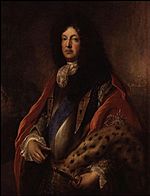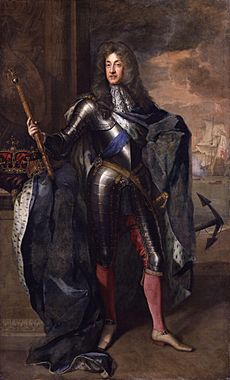Patriot Parliament facts for kids
The Patriot Parliament was a special meeting of the Irish Parliament called by King James II. This happened during the Williamite War in Ireland, which was a big conflict from 1688 to 1691. This Parliament only met once, from May 7 to July 20, 1689. It was the first time the Irish Parliament had met since 1666! The name "Patriot Parliament" was first used much later, in 1893, by an Irish historian named Sir Charles Gavan Duffy.
The House of Commons (like a lower house of Parliament) was missing 70 members because there were no elections in the northern parts of Ireland. Because of this, most of its members were Old English and Catholic. Sir Richard Nagle was chosen as the Speaker, who leads the discussions. The House of Lords (the upper house) was led by Baron Fitton. The main opposition leader was Anthony Dopping, a bishop from the Church of Ireland.
People have different opinions about the "Patriot Parliament" because it was very divided. Sadly, its official records were destroyed after 1695. This means that what we know about it comes from individual stories and accounts, which can be different depending on who wrote them.
Contents
Why the Parliament Met: The Background
King James II became king in 1685. Even though he was Catholic, many people in England, Scotland, and Ireland supported him at first. They worried that if he wasn't king, there might be a civil war. However, by 1688, things changed, and it seemed only his removal could prevent a war. He was removed from power by William III and his wife Mary II in November 1688. This event is known as the Glorious Revolution. James then went to France, where King Louis XIV helped him.
King Louis XIV wanted to use England's money and soldiers for a big war in Europe called the Nine Years' War. The easiest way to do this was to start a war in Ireland, where James had a lot of support. James didn't really want to fight in Ireland because he wanted to get his English throne back. But the French insisted, and so he arrived in Ireland on March 12, 1689.
Most people in Ireland were Catholic (about 800,000, or nearly 75% of the population). They supported James because he was Catholic too. About 75,000 people belonged to the Protestant Church of Ireland, and some of them also supported James. There was a third group of about 200,000 Protestants who were not part of the Church of Ireland. Many of them lived in Ulster, where they made up almost half the population. James hoped they would support him, but they didn't.
For many Catholics, the most important things were to get rid of the penal laws. These laws stopped them from holding public jobs. They also wanted changes to land ownership. By 1685, Irish Catholics owned only 22% of the land, down from 90% in 1600. Most of this land was owned by wealthy Catholic Old English families. There were also Catholic and Protestant business people who didn't like the rules that limited Irish trade. King James had continued these rules even before he was removed from power.
Some Irish leaders, like the Earl of Tyrconnell, wanted Ireland to have more control over its own affairs. But King James wanted England, Scotland, and Ireland to be one strong country where Parliament and the church simply followed the king's orders. James also claimed he had the right to choose Catholic bishops and priests in his kingdoms, which caused problems with Pope Innocent XI.
Irish Catholics supported James because of his religion and because they hoped he would meet their demands. For example, a poet named Dáibhí Ó Bruadair celebrated James becoming king in 1685, hoping it would mean Catholicism and the Irish language would become more important. The Earl of Tyrconnell also made the army bigger by adding Catholic soldiers. This was seen as a good thing by people like Diarmuid Mac Carthaigh, who felt it would help native Irish people gain power over English Protestants.
On the other hand, most Irish Protestants believed James's policies would "completely ruin the Protestant and English interests in Ireland." While James hoped to get their support, only a few Protestant leaders and Catholic converts supported him. They thought his removal from power was wrong. Many Protestants felt sympathy for James, but only a few Church of Ireland ministers refused to promise loyalty to the new King William and Queen Mary. These were called Non-Jurors. A famous one was Charles Leslie.
Who Was in the Parliament?

In March 1689, King James arrived in Ireland and called for the first Irish Parliament since 1666. The Earl of Tyrconnell made sure that most of the voters would be Catholic. He did this by changing the rules for boroughs (towns that could elect members to Parliament). He added Catholics to city councils and removed "disloyal" (mostly Protestant) members. Because of the war, elections couldn't be held in Fermanagh and Donegal. This meant the Commons was missing seventy MPs. Out of the members who were there, six were Protestant and 224 were Catholic.
Sir Richard Nagle, a rich lawyer and close friend of Tyrconnell, was the leader of the Commons. The Lords was led by Baron Fitton. He had been in prison for many years before this. James supposedly chose him because he was Protestant, but Fitton quickly became Catholic. The Lords included five Protestant nobles and four bishops from the Church of Ireland. The Bishop of Meath was the main leader of the opposition.
A French diplomat noticed that James had "a heart too English to do anything that might upset the English." James saw the war in Ireland as a side task to help him get his English throne back. He was not happy about making promises to Irish Catholics because it made him lose support from Protestants in England and Scotland.
This meant that even though Tyrconnell was loyal to James, some Catholics who had benefited from the 1662 Land Settlement didn't trust James. These Catholics, led by the Earl of Limerick, wanted to keep the gains they had made under Tyrconnell. Some of them had bought land that was taken away in 1652, including Tyrconnell, Limerick, and even James himself. This put them against those who wanted to go back to how things were in 1641 and allow Catholics to hold government jobs again. While these people were a minority in Parliament, they were a majority in the country.
Historically, people often saw these differences as a split between Irish Gaels and Old English. In 1692, a historian named Charles Kelly even said that Tyrconnell weakened their cause by opposing the Gaels. There is some truth to this, especially because Parliament didn't deal with payments for lands taken before 1641. Much of this land belonged to Gaelic landowners in Ulster, especially after Tyrone's Rebellion in 1603. Today, historians think these differences were mostly about money. Those who gained from the 1662 Settlement were mostly Old English, while those who didn't were mostly Gaelic.
Important Laws Passed
The 1689 Parliament "ended up going much further than James would have liked, while ... falling short of what many Irish Catholics hoped for." The Parliament was called to raise money for the war. It agreed to provide £20,000 each month for 13 months, but it had no way to actually get this money.
The Act of Recognition said that James was the rightful King of Ireland. It compared William III taking the throne to the murder of James's father, Charles I. This law stressed that kings have a natural right to rule and that their power comes from God. This was different from the English Bill of Rights and Scottish Articles of Grievances from 1689, which said that there was an agreement between a king and his people.
The Declaratory Act stated that the Kingdom of Ireland had always been "separate" from England. It also said that no law passed by the English Parliament was valid in Ireland unless the Irish Parliament approved it. However, Poynings' Law remained in place. This law, created in 1494, basically allowed the English Parliament to make laws for Ireland. James didn't want to get rid of it.
Land Settlement: Despite opposition from Protestants in the Lords, and the few Catholics who had bought land since 1660, Parliament refused to approve taxes until James agreed to cancel the 1652 Cromwellian Settlement and the Act of Settlement 1662. However, it did not address payments for lands taken before 1641. Many of these lands belonged to Gaelic landowners, especially those lost after Tyrone's Rebellion in 1603.
A Bill of Attainder named 2,470 Protestants as traitors. This meant their property could be taken, and they could lose their lives. Many people thought this was a bad idea, but it was the only way to raise money for the taxes Parliament had voted for. After the war was lost, this law was used to take even more land.
An Act for Liberty of Conscience allowed freedom to worship for Roman Catholics and Protestant Dissenters. It also gave them equal rights in society and politics. It got rid of the Oath of Supremacy. However, it kept the Act of Uniformity. While James wanted to stop punishments against religious freedom, he saw the Church of Ireland as very important for his support and wanted to keep it, even though he was Catholic.
What Happened After?
After they lost the Battle of the Boyne in July 1690, James's supporters left Dublin and went to Limerick. James himself left Ireland. After the war ended with the Treaty of Limerick in October 1691, all the laws passed by the Patriot Parliament were declared invalid by the Parliament of England. The Irish Parliament in 1695 passed a law saying that all actions of the "late pretended Parliament" were void and ordered its records to be destroyed.
For Irish nationalists in the 1800s, the most important thing the 1689 Parliament did was declare that Ireland should be in charge of itself. Just before he died in 1843, a leader of the Young Ireland movement, Thomas Davis, wrote a history of the Parliament. He directly connected it to the 1798 Rebellion. The term "Patriot Parliament" was first used in 1893 by the Irish nationalist historian Sir Charles Gavan Duffy.


